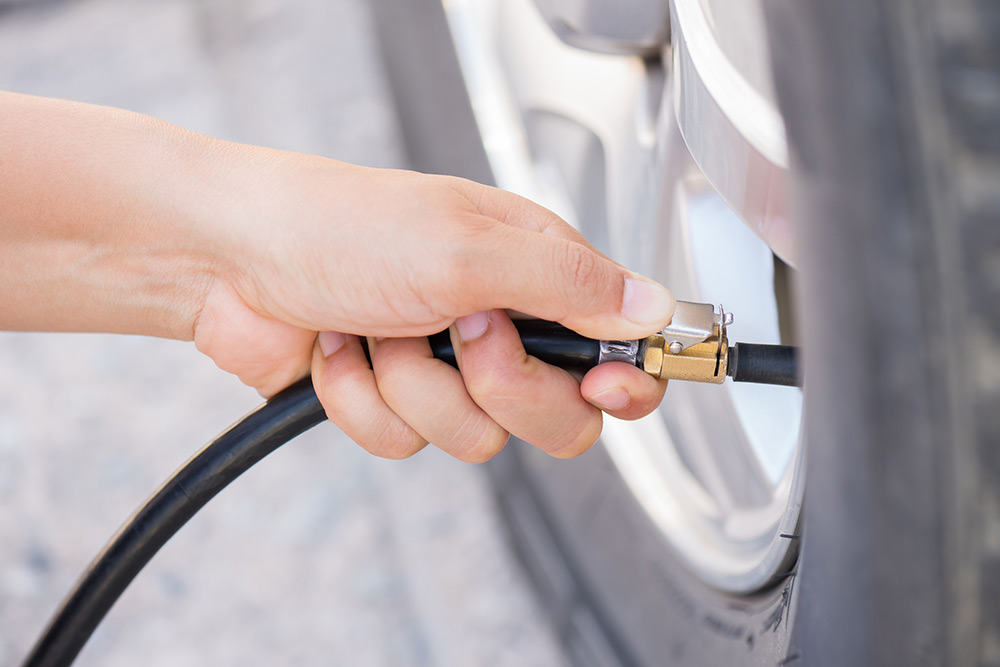How to check your car tyre pressure
Checking your car tyre pressure is one of those routine maintenance tasks that can easily be overlooked.

Why it's important
Safety first
Properly inflated tyres ensure optimal traction and handling. Under-inflated tyres can increase stopping distances and reduce manoeuvrability, especially in emergency situations.Fuel efficiency
Incorrect tyre pressure can significantly affect fuel efficiency. Under-inflated tyres create more rolling resistance, which means your engine has to work harder and burn more fuel to move the vehicle.Tyre longevity
Over-inflated or under-inflated tyres wear out faster and unevenly, leading to premature replacement and increased maintenance costs.Checking your tyre pressure
To check your tyre pressure, you will need a tyre pressure gauge. It is worth spending more for quality to ensure you get an accurate reading and that the gauge will last.
Many newer cars also alert when the tyre pressure dips below the recommended pressure.
Many, but not all, service stations offer air pumps as a free service. Use these to check your tyre pressure and add air if required.
It is worth noting that service stations are not required to have air pumps and if the equipment is damaged they have no obligations or timeframes to have it repaired.
You should check your tyre pressure at least once a month and before long trips.
Tyre pressure should ideally be checked when the tyres are cold (driven less than 1.5km). This gives the most accurate reading because as a vehicle is driven, the tyre sidewall flexes, creating heat that raises the tyre pressure.
The recommended tyre pressure is found in your vehicle's owner's manual or on a tyre placard, which is usually located inside the driver's side door jamb, fuel flap or glovebox lid.
Unscrew the valve cap on the tyre, press the gauge firmly onto the valve stem and read the pressure displayed.
RACQ Roadside Assistance: We're there when you need us
Air pumps without a gauge attached to the hose have a digital display on the main unit.
When inflating the tyre, be sure to press the hose securely on to the valve. If not, the air pump will detect an air leak, which will cause an error and cause the compressor to stop.
If the pressure is too low, inflate the tyre to the recommended pressure.
If the tyre pressure is too high, release some air by gently pressing the centre of the valve stem with the gauge.
Repeat this process for all four tyres, and remember to check the spare tyre as well. RACQ’s Roadside patrol teams often get called to change flat tyres only to find that the spare is also flat.
If a tyre is completely flat, the air pump cannot detect when the hose is attached as there is no pressure. When this occurs, a separate button on the machine starts inflation. The button is usually marked with an ‘!’ and reads ‘Flat tyre only’.
While checking pressure, it's also a good idea to visually inspect the tyres for signs of damage or uneven wear.
This can indicate alignment issues, the need for tyre rotation or replacements.
Related topics
Things to note
The information in this article has been prepared for general information purposes only and is not intended as legal advice or specific advice to any particular person. Any advice contained in the document is general advice, not intended as legal advice or professional advice and does not take into account any person’s particular circumstances. Before acting on anything based on this advice you should consider its appropriateness to you, having regard to your objectives and needs.
Insurance Products (excluding Travel Insurance) are issued by RACQ Insurance Limited ABN 50 009 704 152 (RACQI) and arranged by its agent, RACQ Distribution Services Pty Ltd (RDS) ABN 35 116 361 650, AFSL 567130 and RDS' authorised representatives (including RACQ Operations Pty Ltd ABN 80 009 663 414, AR No. 234978 (RACQO). Conditions, limits and exclusions apply. RDS and RACQO are in the RACQ group of companies. One of the companies in the RACQ group of companies has a minority shareholding in RACQI.
RDS and RACQO have not taken your personal objectives, circumstances or needs into account when preparing advice regarding insurance products and you will need to consider whether the advice is appropriate for you. Read the Product Disclosure Statement (PDS) and any applicable Supplementary PDS before making a purchase decision on this product. You can also access our Target Market Determinations on this website. RDS receives a commission from RACQI for the policies it arranges. RACQO receives fees paid for services it provides to RDS. Further details about remuneration are available on request prior to purchasing.
Banking and loan products issued by Members Banking Group Limited ABN 83 087 651 054 AFSL/Australian credit licence 241195 trading as RACQ Bank. Terms, conditions, fees, charges and lending policies apply. This is general advice only and may not be right for you. This information does not take your personal objectives, circumstances or needs into account. Read the disclosure documents for your selected product or service, including the Financial Services Guide and the Terms and Conditions, and consider if appropriate for you before deciding.
Except for RACQ Bank, any RACQ entity referred to on this page is not an authorised deposit-taking institution for the purposes of the Banking Act 1959 (Cth). That entity’s obligations do not represent deposits or other liabilities of RACQ Bank. RACQ Bank does not guarantee or otherwise provide assurance in respect of the obligations of that entity, unless noted otherwise.
RACQ Bank subscribes to the Customer Owned Banking Code of Practice which establishes higher standards than the law requires. The Code reflects modern consumer expectations and developments in approaches to issues such as consumer vulnerability, guarantors, and supporting customers through financial hardship. Please read our Customer Owned Banking Code of Practice page for more information.
RACQ Operations Pty Ltd (ABN 80 009 663 414 AR 000234978) and Members Travel Group Pty Ltd (ABN 45 144 538 803 AR 000432492) are acting as an Authorised Representative of the issuer of the insurance, Tokio Marine & Nichido Fire Insurance Co., Ltd. (ABN 80 000 438 291 AFSL 246 548). Any advice set out above is general in nature only, and does not take into account your objectives, financial situation or needs. Before purchasing any travel products, please consider the RACQ Travel Insurance Product Disclosure Statement (PDS) and the Target Market Determinations (TMDs) that apply to these products. Whilst the PDS outlines the Terms and Conditions of these products, the TMDs outline the intended class of customers that comprise the target market for these travel products. This will allow you to consider which products best suit your objectives, financial situation and needs and consider the products appropriateness to your personal circumstances. TMDs also outline matters involving the distribution and the review of these products. The PDS, Supplementary PDS and TMDs for each travel product can be found here.
